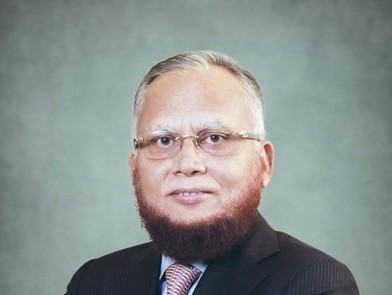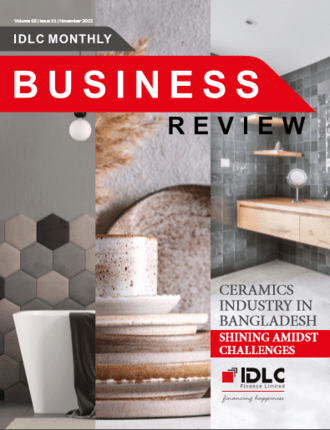
EXPERT OPINION ON COVER STORY
M. A. Rahim Vice Chairman, DBL Group
Interviewed by Ashraf Uz Zaman
Mr. M. A. Rahim is the Vice Chairman of DBL Group, established in 1991. Mr. Rahim is a director of the Bangladesh Garment Manufacturers and Exporters Association. He is also on the Trustee Board of CSR Centre Bangladesh. Mr. Rahim’s leadership allowed DBL to receive low-cost finance from various Development Financial Institutions including the IFC of the World Bank Group and KfW-DEG. He also contributed to DBL in earning local and international recognitions including the HSBC Export Excellence Awards (five times), Textile Institute Sustainability Award (UK) and Carbon Performance Improvement Award (Germany). Team MBR was in a conversation with Mr. M. A. Rahim and was fortunate enough to receive his take on the ceramics industry in Bangladesh.
Ashraf Uz Zaman: The ceramics industry of Bangladesh experienced an average annual growth rate of 20% over the last decade in the domestic market. What are the key factors that you think drove this phenomenal growth?
M. A. Rahim: Over the last decade, Bangladesh’s ceramics sector has grown by 20% every year, on average. Since the real estate market is booming and people’s incomes are improving, this expansionary trend may continue for some time. This phenomenal growth is mostly attributable to the improvement of the country’s housing market. The use of ceramic tiles has become commonplace in modern architecture. A growing middle class means more people are willing to spend more on upscale necessities like dinnerware and bathroom fixtures.The combination of competitive prices, plentiful skilled workers, and innovative business owners positions this sector for rapid growth in internationalmarkets. Countries with long histories of producing ceramics, like Italy and Spain, are facing severe challenges as a result of increased labour costs. Therefore, more business is being shifted to nations with lower labour costs, like Bangladesh. Ceramics produced in Bangladesh are on par with those made in China and India. With the correct incentives and government backing, we have the potential to become a global leader in ceramics exports. Bangladesh’s manufacturing sector would see another success story in this case, following the garment industry’s lead.
Ashraf Uz Zaman: More large conglomerates are entering the ceramics industry, and the existing industry participants are expanding their production capacities. What are the motivations for large conglomerates to engage themselves in this particular industry?
M. A. Rahim: Bangladesh’s ceramics industry has a bright future because of the country’s booming construction industry and the increasing demand for high-end residences. As the country’s economy and population rise, so does the demand for ceramic goods. These were the primary drivers for the big corporations’ entry into the field.As a result of rising demand, major corporations are pouring millions of taka into the industry. They have many factories up and running. One of Bangladesh’s expanding industrial sectors is the ceramics industry. The industry is meeting 85% of domestic demand and a significant amount of the international market, positioning itself as one of the biggest in the next five years.
Ashraf Uz Zaman: Our ceramics products are being exported to more than 50 countries after meeting more than 85% of the local demand. What attributes of Bangladeshi ceramics products have helped Bangladesh stand out in the global market?
M. A. Rahim: Bangladesh’s advantageous qualityto-cost ratio and innovative labour force make it a top contender in this industry, helping the sector earn a solid reputation in export destinations, including the Middle East, North America, and the European Union. Tiles, crockery, and plumbing fixtures made of ceramics are also prospering. The country’s ceramics sector relies heavily on technical competence and experienced labour in tiles, tableware, and sanitary ware. Insulators and sanitary equipment are in high demand both at home and abroad.
Ashraf Uz Zaman: Though value addition in the ceramics industry has improved significantly over the years, the industry still has to largely depend on imports for raw materials. Would you kindly share your thoughts regarding the potential of complete backward linkage happening soon in the industry?
M. A. Rahim: Although rivals like China and India manufacture their own raw materials, the companies in Bangladesh depend largely on imported raw resources like clay, feldspar, and quartz. The price of raw materials has a significant impact on the overall cost of manufacturing. The primary expense in Bangladesh’s ceramics sector is the price of raw materials, followed by the cost of electricity and human labour. The majorityof the raw materials (white clay, feldspar, and quartz) used by producers come from China, India, Thailand, Malaysia, Indonesia, and the European Union, while white clay deposits may be found in Mymensingh (Bijoypur), Sylhet, and Netrokona as well.In order to better depend on local raw material manufacturing, we must improve our current methods. Clay, one of the most critical raw materials for ceramics items, is still imported despite the fact that Mymensingh has a rich clay mine with a capacity of up to 3 million tonnes of clay. The areas of Chittagong, Sherpur, and Netrokona are also likely to produce white clay surface sediments.
Ashraf Uz Zaman: Natural gas is one of the key raw materials for the ceramics industry. How is the industry being impacted by the volatility in the supply and price of natural gas? What are your suggestions to overcome this challenge?
M. A. Rahim: This industry relies heavily on natural gas, and the reliability of its supply is a crucial factor in establishing and maintaining high-quality standards. Compressed Natural Gas (CNG) and Liquefied Natural Gas (LNG) are viable alternatives, but they are not cost-effective, and supply shortages are a significant challenge in this industry. To sustain their local clientele, producers should not drastically alter their prices. As a result, we should expect gas prices to be steady.
Ashraf Uz Zaman: The industry has experienced notable FDI inflows from China and the Middle East. What features of the industry have attracted foreign investors to invest in the ceramics industry of Bangladesh?
M. A. Rahim: Bangladesh stands out in the international market due to a number of factors.The ceramics industry in Bangladesh has become one of the country’s fastest-growing sectors as a result of rising incomes and increasing urbanization. As the economy develops and more people move to the cities, there is a rising need for ceramics. By 2025, between 30 and 40 million individuals are expected to enter the lower middle class, and another 34 million are expected to see their income rise and move into the upper middle class, allowing them to enjoy a more comfortable lifestyle based on a study by the Boston Consulting Group. The future prospect for sector expansion is indicated by rising population affordability, rising real estate development, and potential changes in urban inhabitants’ lifestyles as a consequence of rapid urbanization.Bangladesh’s ability to increase export competitiveness is demonstrated by the fact that it enjoys duty- and quota-free access to developed nations (Generalized System of Preferences: GSP) like the European Union (EU), the United Kingdom, Japan, Canada, Russia, Australia, and New Zealand. Chinese ceramics, a significant rival of Bangladesh’s, must pay additional duties to enter these markets. Additionally, Bangladesh has emerged as a viable option for investors looking to develop their ceramics enterprises.Bangladesh’s export-focused businesses benefit greatly from the country’s highly skilled worker population because of the country’s relatively low wage rates. The Bangladeshi ceramics sector has been and will continue to benefit from the considerably reduced labour costs available for domestic manufacture while facing stiff competition from China, India, and Thailand in the international market.New innovations in the ceramics industry are being developed as a result of collaboration between industry and universities in Bangladesh. When it comes to Solar Grade Silicon, for instance, DBL Ceramics has teamed up with BUET’s Glass and Ceramic Engineering (GCE) department.
Ashraf Uz Zaman: Hikes in the prices of all the major construction materials have slowed down the construction industry. How is this impacting the ceramics industry of Bangladesh in turn?
M. A. Rahim: Indeed, the construction industry has slowed down due to the increase in the price of all essential construction materials. It has had far-reaching effects on the global supply chain. The construction materials sector and the ceramics industry both suffered as a consequence of the instability of the global supply chain. Manufacturers, consumers, and other parties involved in this industry are now up against supply constraints and rising costs at the checkout counter.
Ashraf Uz Zaman: Since our ceramics industry is heavily reliant on imports for raw materials, rising dollar prices are pushing up the cost of manufacturing ceramics products. What strategies have the leading ceramics product manufacturers undertaken to battle this issue?
M. A. Rahim: With the rise in dollar prices, the cost of ceramics products also goes up. But due to price competition with foreign products, the prices of domestic ceramics products can’t be increased arbitrarily. As a result, we have undertaken some strategies. DBL Ceramics tries to use imported substitute materials like feldspar and clay even though we depend heavily on imported raw materials. Furthermore, DBL Ceramics is trying to set up backward linkage, considering the potential of the backward linkage and the consequences of heavily depending on imported raw materials.

CERAMICS INDUSTRY IN BANGLADESH: RISING AMIDST CHALLENGES
With a total market value of over 6,000 crores, the ceramics industry in Bangladesh has been one of the country’s fastest-growing manufacturing industries. Thanks to sustained economic growth and increasing urbanisation, the industry meets 85% of domestic demand and has the potential to become the country’s largest export industry in the not-toodistant future. With domestic sales increasing by 20% per year on average, export sales increasing by 26% per year on average in the last three years, and total production capacity increasing by around 200% in the last five years, the industry is poised for future success.
The industry benefits from rising incomes, rapid urbanisation, and duty-free access to some international markets. There is still much to be done to address the problems this industry is facing, such as uninterrupted power and gas supplies, which are essential to continue competing in global markets. If Bangladesh’s ceramics sector can get over the obstacles, it has every chance to develop and increase its contribution to the nation’s foreign exchange earnings. It stands to see what the future holds for this industry.
Md. Shah Jalal
Assistant Manager
IDLC Finance Limited
Download View